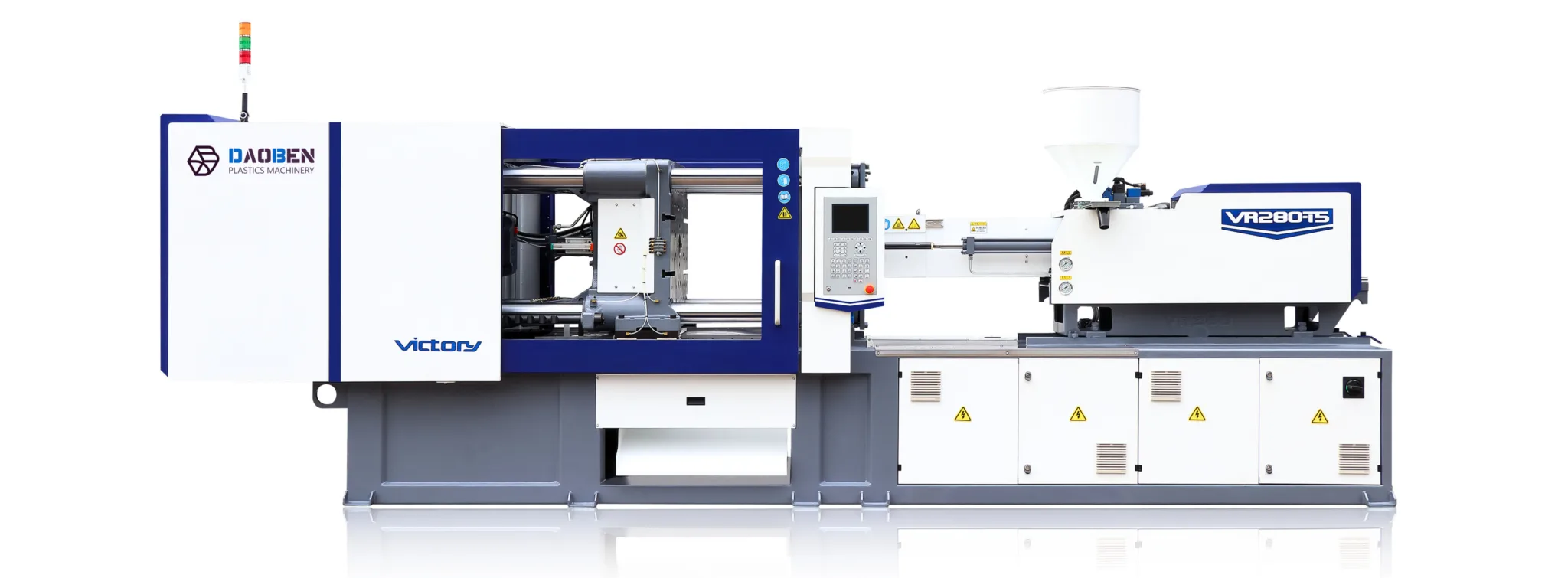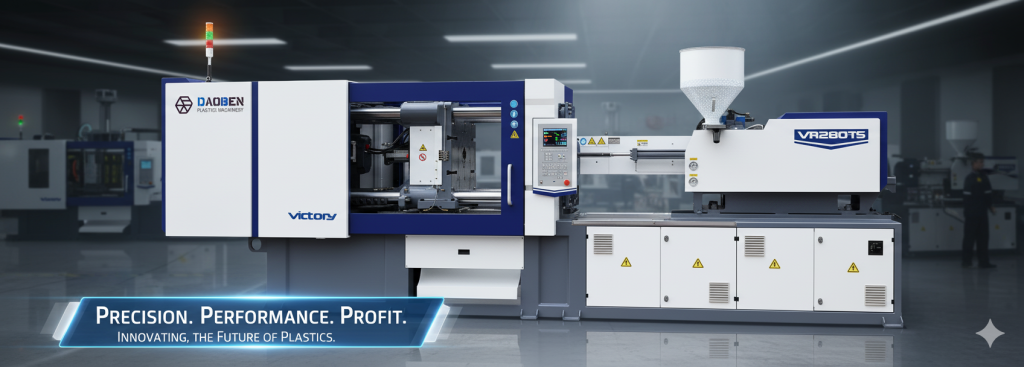Introduction
If you’re exploring a plastic moulding machine for the first time—or you’re upgrading an existing line—you’re really choosing the backbone of your plastics operation. At Daoben Machinery, we build and fine-tune injection moulding machines every day. This guide distills what we tell our own customers: how to pick the right tonnage, what specs actually matter, and how to keep your machine running profitably, shift after shift.
What Is a Plastic Moulding Machine?
A plastic moulding machine (commonly an injection moulding machine) melts polymer pellets and injects the melt into a mould cavity under pressure. After cooling, the tool opens and ejects the finished part. Repeatability, cycle time, and energy use determine your unit cost—and your competitiveness.
Quick Comparison Table (Example Specs)
The table below uses representative specs to show how different models line up. We’ll tailor real specs to your part, material, and cycle targets.
| Series / Model | Clamp Force (t) | Shot Size (cm³) | Screw Diameter (mm) | Energy Saving | Dry Cycle (s) | Best For |
|---|---|---|---|---|---|---|
| Daoben E-120 | 120 | 170 | 35 | Servo (30–60%) | 1.4 | Caps, small housings |
| Daoben E-200 | 200 | 350 | 45 | Servo (30–60%) | 1.7 | Automotive clips, tools |
| Daoben E-320 | 320 | 650 | 55 | Servo (30–60%) | 2.0 | Home appliance parts |
| Daoben H-450 | 450 | 1,100 | 65 | Hybrid (35–65%) | 2.3 | Bumpers, crates |
| Daoben H-650 | 650 | 1,800 | 75 | Hybrid (35–65%) | 2.6 | Large industrial parts |
Types of Plastic Moulding Machines (and When to Use Them)
Electric (Servo-Driven)
- Why choose: Fast acceleration, precise repeatability, low energy consumption, cleaner for medical/electronics.
- Typical use: Thin-wall packaging, precision connectors, micro features.
Hydraulic
- Why choose: Robust clamping and injection force, lower upfront cost, tolerant of recycled materials.
- Typical use: Large parts, thick sections, general-purpose moulding.
Hybrid
- Why choose: Electric precision on critical axes + hydraulic power where it counts.
- Typical use: Automotive, white goods, high-throughput multi-cavity moulds.
How to Size Your Machine (Simple Rules of Thumb)
- Clamping force: Start with 3.5–4.5 tons per cm² of projected part area (include runners). Thin-wall parts may need more.
- Shot size: Target 30–80% of the machine’s maximum shot capacity to avoid material degradation and ensure stable dosing.
- Screw diameter: Match to resin viscosity and throughput. Shear-sensitive materials (e.g., PVC) prefer larger diameters/lower shear.
- Tie-bar spacing / platen size: Ensure mould fits with adequate daylight and stroke for ejection units and auxiliaries.
Not sure? Send us your part drawing, material, and expected cycle time—Daoben engineers will recommend a right-sized machine.
What Really Drives Part Cost
- Cycle Time: Every second saved compounds over millions of shots. Look at injection speed, cooling efficiency, and robot take-out time.
- Energy Consumption: Servo hydraulics and all-electrics cut kWh per kg, especially on multi-cavity tools.
- Scrap Rate: Closed-loop controls, barrel temperature stability, and robust mould protection reduce rejects.
- Uptime: Preventive maintenance and real-time monitoring keep OEE high.
Materials & Process Windows (At a Glance)
- PP / PE: Wide window, forgiving; great for caps, containers.
- ABS / PC / PC-ABS: Needs tighter temperature control; ideal for housings requiring impact strength.
- Nylon (PA6/PA66): Hygroscopic—dry thoroughly; strong, wear-resistant parts.
- PET / PBT: Short residence time, fast cycles; watch hydrolysis.
- PVC: Shear/temperature sensitive; prefer low-shear screws and corrosion-resistant barrels.
Real-World Story
A home-appliance supplier came to us with a warp issue on a PC-ABS panel. We mapped cavity temperature, switched to a Daoben E-320 with faster, tighter hold-pressure control and balanced cooling. Result: scrap down 42%, cycle time −1.6 s, and a calmer night shift.
Why Daoben Machinery
- Process-first engineering: We tune moulding machines around your mould and resin, not the other way around.
- Energy-smart platforms: Servo and hybrid drives that consistently cut kWh without sacrificing speed.
- Service that sticks: Remote diagnostics, on-site start-ups, operator training, and spare parts support.
- Scalable portfolio: From 60-ton precision workhorses to 1,000-ton heavy hitters.
Maintenance Essentials (Pro Tips)
- Daily: Check oil level & leaks, clean filters, verify heaters and thermocouples, inspect safety interlocks.
- Weekly: Calibrate nozzle/platens alignment, check tie-bar lubrication, examine hoses.
- Monthly: Back-pressure and cushion consistency review, screw/back-flow valve wear check, regen battery/UPS test.
- Quarterly: Oil analysis, linear guide inspection, encoder and pressure sensor calibration.
- Annually: Full preventive overhaul; update control firmware and HMI backups.
Common Defects & Fast Fixes
- Short Shot: Raise melt temp slightly, increase injection speed/pressure, verify venting.
- Flash: Lower injection pressure/hold pressure, inspect parting line, check clamp tonnage.
- Sink / Voids: Boost holding pressure/time, raise mould temp, review rib thickness.
- Warp: Balance cooling, tweak gate location/size, adjust packing profile.
Automation & Industry 4.0 Ready
- Robotics: IML, insert over-moulding, and high-speed take-out.
- Sensors: Cavity pressure, mould temperature, and vision inspection.
- Data: OEE dashboards, alarm analytics, recipe versioning, and ERP connectors.
ROI Snapshot (Illustrative)
If servo efficiency saves 12 kWh per hour versus a legacy hydraulic and you run 20 h/day at $0.10/kWh, that’s $24/day or ~$8,760/year—before counting scrap reduction and labor wins. Over a 5-year horizon, energy alone can pay for a substantial share of your upgrade.
FAQs
Match clamp force to projected area (3.5–4.5 t/cm²), shot size to 30–80% of barrel capacity, and verify mould fits the tie-bar spacing.
Electrics = precision & efficiency; hydraulics = power & lower capex; hybrids blend both. We’ll recommend based on your parts, resin, and takt time.
Yes—IQ/OQ/PQ support, process capability (Cp/Cpk), and documentation for regulated industries.
Absolutely—operator & process training, maintenance workshops, and on-site start-ups.



